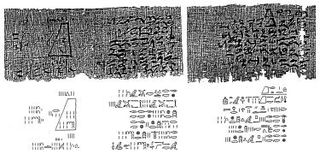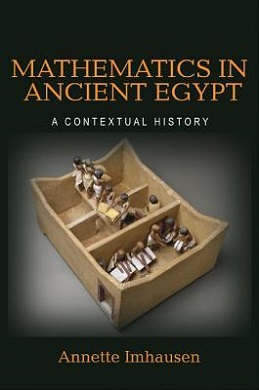In mathematics, a continued fraction is an expression obtained through an iterative process of representing a number as the sum of its integer part and the reciprocal of another number, then writing this other number as the sum of its integer part and another reciprocal, and so on. In a finite continued fraction, the iteration/recursion is terminated after finitely many steps by using an integer in lieu of another continued fraction. In contrast, an infinite continued fraction is an infinite expression. In either case, all integers in the sequence, other than the first, must be positive. The integers are called the coefficients or terms of the continued fraction.

An Egyptian fraction is a finite sum of distinct unit fractions, such as

Proofs of the mathematical result that the rational number 22/7 is greater than π (pi) date back to antiquity. One of these proofs, more recently developed but requiring only elementary techniques from calculus, has attracted attention in modern mathematics due to its mathematical elegance and its connections to the theory of Diophantine approximations. Stephen Lucas calls this proof "one of the more beautiful results related to approximating π". Julian Havil ends a discussion of continued fraction approximations of π with the result, describing it as "impossible to resist mentioning" in that context.

A unit fraction is a positive fraction with one as its numerator, 1/n. It is the multiplicative inverse (reciprocal) of the denominator of the fraction, which must be a positive natural number. Examples are 1/1, 1/2, 1/3, 1/4, 1/5, etc. When an object is divided into equal parts, each part is a unit fraction of the whole.
The system of ancient Egyptian numerals was used in Ancient Egypt from around 3000 BCE until the early first millennium CE. It was a system of numeration based on multiples of ten, often rounded off to the higher power, written in hieroglyphs. The Egyptians had no concept of a positional notation such as the decimal system. The hieratic form of numerals stressed an exact finite series notation, ciphered one-to-one onto the Egyptian alphabet.
Ancient Egyptian mathematics is the mathematics that was developed and used in Ancient Egypt c. 3000 to c. 300 BCE, from the Old Kingdom of Egypt until roughly the beginning of Hellenistic Egypt. The ancient Egyptians utilized a numeral system for counting and solving written mathematical problems, often involving multiplication and fractions. Evidence for Egyptian mathematics is limited to a scarce amount of surviving sources written on papyrus. From these texts it is known that ancient Egyptians understood concepts of geometry, such as determining the surface area and volume of three-dimensional shapes useful for architectural engineering, and algebra, such as the false position method and quadratic equations.

In number theory, a practical number or panarithmic number is a positive integer such that all smaller positive integers can be represented as sums of distinct divisors of . For example, 12 is a practical number because all the numbers from 1 to 11 can be expressed as sums of its divisors 1, 2, 3, 4, and 6: as well as these divisors themselves, we have 5 = 3 + 2, 7 = 6 + 1, 8 = 6 + 2, 9 = 6 + 3, 10 = 6 + 3 + 1, and 11 = 6 + 3 + 2.

A fraction represents a part of a whole or, more generally, any number of equal parts. When spoken in everyday English, a fraction describes how many parts of a certain size there are, for example, one-half, eight-fifths, three-quarters. A common, vulgar, or simple fraction consists of an integer numerator, displayed above a line, and a non-zero integer denominator, displayed below that line. If these integers are positive, then the numerator represents a number of equal parts, and the denominator indicates how many of those parts make up a unit or a whole. For example, in the fraction 3/4, the numerator 3 indicates that the fraction represents 3 equal parts, and the denominator 4 indicates that 4 parts make up a whole. The picture to the right illustrates 3/4 of a cake.
The Erdős–Straus conjecture is an unproven statement in number theory. The conjecture is that, for every integer that is 2 or more, there exist positive integers , , and for which

The Moscow Mathematical Papyrus, also named the Golenishchev Mathematical Papyrus after its first non-Egyptian owner, Egyptologist Vladimir Golenishchev, is an ancient Egyptian mathematical papyrus containing several problems in arithmetic, geometry, and algebra. Golenishchev bought the papyrus in 1892 or 1893 in Thebes. It later entered the collection of the Pushkin State Museum of Fine Arts in Moscow, where it remains today.
In mathematics, ancient Egyptian multiplication, one of two multiplication methods used by scribes, is a systematic method for multiplying two numbers that does not require the multiplication table, only the ability to multiply and divide by 2, and to add. It decomposes one of the multiplicands into a set of numbers of powers of two and then creates a table of doublings of the second multiplicand by every value of the set which is summed up to give result of multiplication.
The Egyptian Mathematical Leather Roll (EMLR) is a 10 × 17 in (25 × 43 cm) leather roll purchased by Alexander Henry Rhind in 1858. It was sent to the British Museum in 1864, along with the Rhind Mathematical Papyrus, but it was not chemically softened and unrolled until 1927 (Scott, Hall 1927).
The Reisner Papyri date to the reign of Senusret I, who was king of ancient Egypt in the 19th century BCE. The documents were discovered by G.A. Reisner during excavations in 1901–04 in Naga ed-Deir in southern Egypt. A total of four papyrus rolls were found in a wooden coffin in a tomb.

The Rhind Mathematical Papyrus is one of the best known examples of ancient Egyptian mathematics. It is named after Alexander Henry Rhind, a Scottish antiquarian, who purchased the papyrus in 1858 in Luxor, Egypt; it was apparently found during illegal excavations in or near the Ramesseum. It dates to around 1550 BC. The British Museum, where the majority of the papyrus is now kept, acquired it in 1865 along with the Egyptian Mathematical Leather Roll, also owned by Henry Rhind. There are a few small fragments held by the Brooklyn Museum in New York City and an 18 cm (7.1 in) central section is missing. It is one of the two well-known Mathematical Papyri along with the Moscow Mathematical Papyrus. The Rhind Papyrus is larger than the Moscow Mathematical Papyrus, while the latter is older.
In mathematics, a Størmer number or arc-cotangent irreducible number is a positive integer for which the greatest prime factor of is greater than or equal to . They are named after Carl Størmer.
The Lahun Mathematical Papyri is an ancient Egyptian mathematical text. It forms part of the Kahun Papyri, which was discovered at El-Lahun by Flinders Petrie during excavations of a workers' town near the pyramid of the 12th dynasty pharaoh Sesostris II. The Kahun Papyri are a collection of texts including administrative texts, medical texts, veterinarian texts and six fragments devoted to mathematics.

Egyptian geometry refers to geometry as it was developed and used in Ancient Egypt. Their geometry was a necessary outgrowth of surveying to preserve the layout and ownership of farmland, which was flooded annually by the Nile river.
In the history of mathematics, Egyptian algebra, as that term is used in this article, refers to algebra as it was developed and used in ancient Egypt. Ancient Egyptian mathematics as discussed here spans a time period ranging from c. 3000 BCE to c. 300 BCE.
Ganita Kaumudi (Gaṇitakaumudī) is a treatise on mathematics written by Indian mathematician Narayana Pandita in 1356. It was an arithmetical treatise alongside the other algebraic treatise called "Bijganita Vatamsa" by Narayana Pandit.

Mathematics in Ancient Egypt: A Contextual History is a book on ancient Egyptian mathematics by Annette Imhausen. It was published by the Princeton University Press in 2016.











